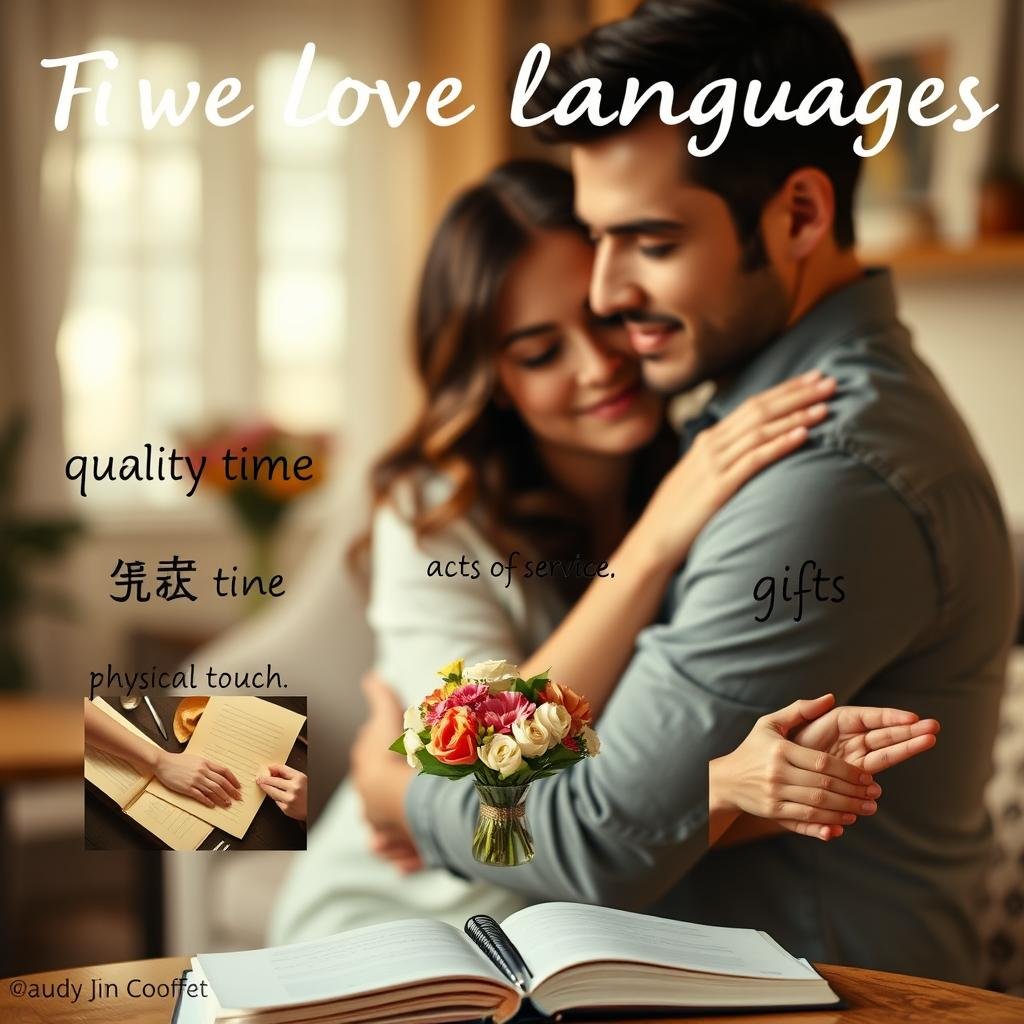Ever felt like something’s missing in your relationship? What if the key to a deeper emotional connection is speaking the right language? Dr. Gary Chapman’s book, “The 5 Love Languages”, has helped millions understand love better. But is there more to it?
Relationships flourish when love is shared in ways our partners feel. Yet, 40% of married couples still feel unfulfilled. Discover why “love languages” are important and just the beginning of your journey. Ready to bridge that gap? Watch our video to see how love languages work in real life.
Key Takeaways
- Dr. Gary Chapman’s model identifies five core ways people experience love: words, acts, gifts, time, and touch.
- Over 11 million copies sold globally prove its popularity—but new research challenges its core assumptions.
- Healthy relationships need a “love diet” balance, not rigid categories.
- 60% of couples report higher satisfaction when partners perceive their love language is understood.
- Physical touch is a universal love language—no culture exists where gifts don’t signal care.
Understanding Love Languages: An Overview
Ever felt like your partner’s gestures never hit the mark? Love language is the secret code shaping how we give and receive affection. Dr. Gary Chapman’s groundbreaking book—selling 20 million copies in 49 languages—reveals why this framework resonates globally. Think of these languages as your emotional compass in communication in relationships—simple yet transformative for bridging gaps.

Chapman identified five core love languages shaping how we feel cherished:
- Words of Affirmationion
- Quality Time
- Physical Touch
- Acts of Service
- Receiving Gifts
Recent studies hint at nuances. While some research shows mismatched couples can thrive, others note heightened satisfaction when partners align. What matters most? Recognizing that everyone has a primary language—and that flexibility matters. Women navigating dating or long-term partnerships can use this knowledge to decode unspoken needs. Communication in relationships deepens when you shift from guessing to understanding.
Today’s evolving frameworks like the Routes of Safety model show growth since Chapman’s 1992 work. Yet his core idea remains timeless: love isn’t one-size-fits-all. By embracing this lens, you turn confusion into connection. Ready to speak your partner’s language?
The Five Love Languages Explained
Every act of expressing affection or showing appreciation matters. Let’s explore how each love language shapes connection:
“The love languages are the primary ways people give and receive emotional nourishment.” — Gary Chapman, The 5 Love Languages

Words of Affirmation
Verbal praise and encouragement are key here. Saying “I notice your effort” or sharing why they matter to you builds trust. These words remind them of their value every day.
Acts of Service
Doing chores, planning date nights, or fixing a flat tire—showing appreciation through action. For some, practical help speaks louder than words.
Receiving Gifts
Thoughtful gifts (even small ones) signal “you’re on my mind.” It’s less about the gift’s cost and more about the intention behind it.
Quality Time
Phone-free conversations, shared hobbies, or simply laughing together creates bonds. Full attention turns moments into memories.
| Love Language | Key Action | Example |
|---|---|---|
| Words of Affirmationion | Verbal praise | “Your kindness inspires me!” |
| Acts of Service | Helping with tasks | Preparing dinner after a long day |
| Receiving Gifts | Symbolic gestures | A handwritten note with a coffee gift card |
| Quality Time | Undivided attention | A weekly sunset walk |
Remember: Chapman’s framework is a guide, not a rule. Life changes—like new jobs or parenthood—may shift preferences. The key is to stay curious. By learning these patterns, you’ll decode how to expressing affection in ways that truly resonate.
Physical Touch: The Fifth Love Language
Physical touch is more than just a surface-level thing. It’s a way to connect deeply with someone. A hug, a handhold, or a gentle shoulder squeeze can mean “I love you” more than words ever could. It’s like a secret language that says, “I care about you deeply.”

“Touch is our first language,” says Dr. Emily Impett, whose 2024 research shows how simple touches can calm us down and make us feel closer.
Let’s look at some examples:
- Small touches, like brushing a hand while walking, make us feel safe.
- Long hugs after fights can help us feel balanced again.
- Spontaneous cuddles during quiet moments can build trust.
A 2020 University of Arizona study found that 87% of couples felt closer when they made touch a priority. But it’s not about how often you touch. It’s about how meaningful those touches are. A quick kiss might not be enough. Try holding their hand or giving a warm back rub instead.
Don’t worry about being too much. Start with small gestures. A lingering handshake or holding hands while walking can be powerful. These actions show love in a way that words can’t. When touch feels right, it tells us, “You’re important,” without needing to say a thing.
The Significance of Each Love Language
Love languages are like emotional codes that shape relationship dynamics. When partners speak the same language, small gestures can bridge them closer. For example, a handwritten note or a walk together can mean a lot. Studies show that understanding emotions through love languages can reduce conflicts.
Couples who share the same language often feel 30% more satisfied. But, not all need to share the same language to be happy. What’s key is being fluency—adjusting to your partner’s needs, even if they’re different from yours.

“I thought cleaning the house was love enough, but he just wanted to talk. I realized my acts of service were like speaking French to someone who only understands Spanish.”
Here’s how to decode your partner’s language:
- Notice what they request most—a date night, a gift, or physical touch.
- Listen to complaints about what’s missing, like “You never listen” (Quality Time) or “You forget to hold my hand” (Physical Touch).
- Watch how they express love to you—they’ll often give what they crave most.
Love languages are not strict rules but tools for empathy. A 2020 study found women who understand this feel 2x more emotionally understood. But, they don’t solve deeper issues like trust or respect. Start small: try one gesture in their language this week. Small steps can build trust and start real connection.
Assessing Your Love Language

Knowing your love language begins with honest self-reflection. Start with the love languages quiz by Dr. Gary Chapman. It’s a quick way to find your top preferences. But remember, numbers only tell part of the story. True understanding emotions comes from deeper questions.
What actions make you feel most cherished? What leaves you feeling overlooked?
Begin by taking the quiz at 5lovelanguages.com. Then, think about moments when you felt truly seen. Did his thoughtful words lift your mood? Or did a shared adventure leave you feeling connected? These clues are more important than categories.
Simple Tests to Discover Your Primary Love Language
- Take the love languages quiz but review the questions again—did your answers align with how you felt during key relationships?
- Track your reactions. Do you thrive when someone plans a surprise date (Quality Time) or when they fix small frustrations (Acts of Service)?
Reflecting on Past Relationships
Look at past conflicts. Did you feel ignored when he forgot your birthday? Or hurt when he prioritized work over time with you? Patterns here show your core needs. For example:
- If past partners’ gifts felt empty, maybe Acts of Service or Quality Time matter more to you.
- If compliments reignited passion, Words of Affirmation might be your primary language.
Understanding your own love language isn’t about labels—it’s about owning what you need to feel loved. Once you see your own needs clearly, you’ll avoid projecting them onto others. That’s when real connection begins.
Common Misconceptions About Love Languages
Love languages guide us, but they’re not absolute. Let’s debunk myths that confuse couples daily. 
- Myth 1: Love languages never change. Truth? Life shifts like stress or new responsibilities can temporarily shift what feels nurturing.
- Myth 2: Chapman’s model is scientifically proven. Research shows his “five languages” lack peer-reviewed validation—yet their emotional logic remains valuable.
- Myth 3: You can guess your partner’s language. Surveys show 68% of couples assume shared preferences—leading to unmet needs and frustration.
- Myth 4: Physical touch = romance. For many, a simple hand-hold or hug matters more than grand gestures—without any sexual undertones.
Communication in relationships is more than just love language labels. A 2022 study found couples who treated love languages as rigid rules saw no boost in satisfaction. Healthy relationship dynamics require balancing your needs with your partner’s—no one-size-fits-all equation here.
“Love languages are a starting point, not a blueprint.”
Remember: Flexibility beats perfection. Celebrate the framework’s insights while staying open to your unique story. Let’s move beyond labels and into the messy, beautiful reality of human connection.
Love Language Compatibility: Finding Your Match
Did you know that mismatched love languages don’t have to be a barrier? Over 11 million readers of The Five Love Languages have learned that compatibility isn’t about sameness—it’s about curiosity. Let’s explore how embracing differences can enhance intimacy and deepen relationship dynamics.

Many couples think sharing the same love language means harmony. But research shows 60% of relationships thrive when partners learn each other’s styles. Here’s how to turn differences into strengths:
“Love is spelled T-I-M-E—Gary Chapman’s timeless advice reminds us that effort matters more than instinct.”
Tips for Couples with Different Love Languages
- Start small: If your partner’s love language is Acts of Service but yours is Words of Affirmation, try leaving a note saying, “I noticed you organized the pantry—it meant a lot!”
- Swap roles: If one values Quality Time while the other prefers Receiving Gifts, plan a date where you cook together (Quality) and gift each other small tokens afterward.
- Track progress: Use a shared journal to note moments when you’ve felt loved “in their language.” Celebrate these as wins.
Strengthening Relationships Through Understanding
Remember: 55% of couples admit they’ve never discussed love languages. Start today by asking, “What’s one thing I can do this week to speak your love language better?”
By blending curiosity with action, you’ll transform differences into bridges—not walls. When you prioritize relationship dynamics, even small gestures (like a handwritten note or a shared hike) become powerful tools for connection. Let’s make love languages a shared adventure, not a checklist.
Communicating Your Love Language
Talking openly about love languages can change how we see each other. It’s all about being honest in a way that feels safe. This way, we can grow together.

How to Express Your Needs Effectively
See your needs as your own truths, not complaints. Here are some tips:
- Use “I feel” statements: “I love sharing meals without phones.”
- Give examples: “Quality time means a lot to me, just like your efforts do.”
- Ask and listen: “What makes you feel loved?” starts a good conversation.
| Love Language | Effective Expression | Missed Approach |
|---|---|---|
| Words of Affirmation | Write a love note weekly | “You never say nice things to me” |
| Acts of Service | Ask, “How can I help you today?” | “You always leave dishes out” |
| Physical Touch | Initiate a hug when stressed | “We never hold hands anymore” |
| Quality Time | Plan weekly date nights | “You’re always distracted during our talks” |
Encouraging Your Partner to Share Their Language
Men might find it hard to say what their love language is. So, watch and then ask them gently:
- Ask open-ended: “What small acts make you feel cared for?”
- Highlight curiosity: “I’m learning about love languages—what speaks to you?”
- Lead by example: “I share my preferences because I value your understanding”
Remember, expressing affection takes time. Celebrate every small step we take together.
Want to Love Smarter? Explore Further
Understanding your love language is just the start. To build strong relationships, you need practical tools. Our Love Hacks video combines Dr. Gary Chapman’s love languages with proven strategies.
Imagine making small gestures that truly connect. This is the power of expressing affection in your partner’s language.
Watch the Life-Changing Love Hacks Video
Imagine learning how acts of service can be like poetry for someone who values practical help. Discover why a handwritten note can mean more than a big speech for those who love words.
The video shows how different love languages can lead to misunderstandings. But, it also shows how to turn these into opportunities for growth. Over 100,000 people say it’s the key to making love languages work.
Ready to go beyond just getting along? Click here to watch the video: bit.ly/LoveHacks100. It’s perfect for anyone in a relationship, showing how to match your actions with what your partner values. Every click brings you closer to a relationship where love is truly felt.
Source Links
- What the 5 love languages get right, and what they get very wrong
- Fact or Fiction: Chapman’s 5 Love Languages – Olver International
- A tip for better expressing each of the 5 love languages with Dr. Gary Chapman
- Is There Science Behind the Five Love Languages?
- How to Identify Your Love Language
- Everything to Know About the 5 Love Languages
- What Are the 5 Love Languages? Definition and Examples
- The Five Love Languages
- How to receive and express love through the 5 love languages
- Why Everyone’s Talking About Love Languages These Days & How To Find Yours
- 5 Love Languages: How to Receive and Express Love
- Do You Know Your Love Language?
- The Love Language® Quiz
- The 5 Love Languages: What is your Love Language? and How to Speak Your Spouse’s Love Language. – Alive Counselling
- Relationship experts share 7 things people get wrong about love languages
- Love Languages, Myths, and Men Who Feel Unloved – Lindsey Hoskins & Associates
- Common Misunderstandings About Love Languages – From 2 to 3
- Do Couples Need to Share the Same "Love Language"?
- The Love Language You’re Most Compatible With, Based on Your Own
- Love Language Compatibility: The Secret to Relationship Success
- How to Speak Your Spouse’s Love Language (and What to Avoid) – Fierce Marriage
- Applying The 5 Love Languages™ to healthy relationships
- Understanding Love Languages and Intelligence Types: How They Shape Relationships
- Love Language and How to Show Your Partner You Care
